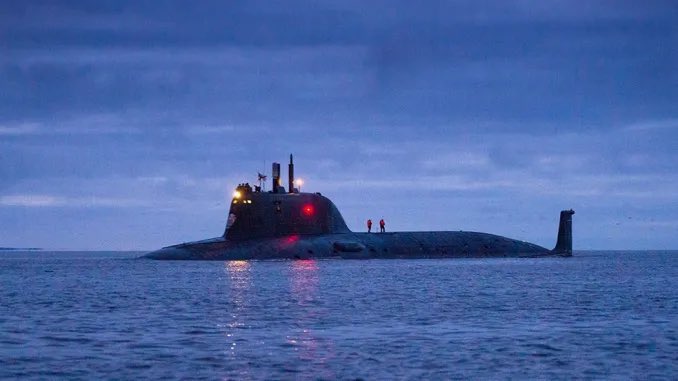US on Full Alert: The Hunt is On as Russian Submarine Threat Looms Near Florida Coast
Ready to uncover the truth? Sick of the lies? Join our Telegram Channel now. It’s time for the real story! My gratitude to all my readers!
US Navy P8 Poseidon ‘Sub Hunter’ is flying over the coast of Florida in search of a rogue Russian submarine!!
US on Full Alert: Russian Submarine Threat Near Florida – A New Cuban Missile Crisis? The US Navy P8 Poseidon hunts for the rogue Russian submarine Kazan, armed with nuclear missiles. Discover the modern-day missile threat and its global implications. Is history repeating itself? Stay informed on the escalating US-Russia tensions.
The United States stands on the brink of a new crisis reminiscent of the darkest days of the Cold War. A rogue Russian submarine, the Kazan, armed with nuclear-capable missiles, has been detected just 66 miles off the coast of Florida. As the US Navy’s P8 Poseidon patrols the skies in search of this underwater threat, the world holds its breath, teetering on the edge of a catastrophe that could eclipse the Cuban Missile Crisis of 1962.
In a chilling echo of history, the waters near Cuba have once again become the stage for a high-stakes geopolitical drama. The Russian Navy’s nuclear submarine Kazan, lurking dangerously close to the US shoreline, is equipped with the formidable Kalibr-M missiles, capable of striking targets up to 4,500 kilometers away. Adding to the tension, the Russian frigate Admiral Gorshkov, armed with hypersonic Zircon missiles, has arrived in Cuba, positioned a mere 180 kilometers from South Florida. These developments signal a potential flashpoint that could escalate into a full-blown conflict.
► Fire and Fury: On the Verge of WWIII – The United States of America, is on the verge of war… And It’s Just Around The Corner
A New Era of Missile Threats. Unlike the ballistic missiles of the 1960s, today’s hypersonic missiles, like the Zircon, represent a quantum leap in warfare technology. Traveling at speeds of Mach 9, or approximately 6,900 miles per hour, these missiles can reach Miami from the Caribbean in just three minutes. The US antimissile defenses, designed to intercept slower, more predictable threats, are virtually powerless against these hypersonic weapons. This technological edge gives Russia a significant strategic advantage, one that could alter the balance of power and escalate tensions to unprecedented levels.
History Repeats Itself: A Dangerous Déjà Vu. During the Cuban Missile Crisis, the world witnessed a tense standoff between President John F. Kennedy and Soviet Premier Nikita Khrushchev. After days of nerve-wracking negotiations and a naval blockade, both leaders ultimately found a path to de-escalation, averting a potential nuclear war. Today, however, the dynamics have shifted dramatically.
Russian President Vladimir Putin, bolstered by his country’s advanced missile capabilities, faces off against a US administration that many perceive as weaker and less decisive.
The stakes are higher now than ever before. Russia’s hypersonic missiles, capable of being launched from submarines, destroyers, or frigates, pose an immediate and unstoppable threat. Unlike the slower ballistic missiles of the past, these weapons can evade current missile defense systems, rendering traditional deterrence strategies obsolete.
The Unstoppable Hypersonic Threat. The sheer speed and maneuverability of hypersonic missiles like the Zircon make them a game-changer in modern warfare. Launched from submerged vessels or surface ships, these missiles can strike with little to no warning, leaving the targeted nation with minimal response time. The implications of such a capability are profound. A single Zircon missile could potentially sink a US Navy aircraft carrier, killing thousands of sailors and crippling American naval power in the region.
The US Department of Defense has acknowledged its inability to intercept these hypersonic threats. This admission underscores the vulnerability of American soil and military assets to a potential Russian first strike. In a chilling declaration, Russia has made it clear that it will target third-party suppliers of military equipment used against it, placing American cities squarely in the crosshairs.
A Leadership Void: Biden vs. JFK
In 1962, President Kennedy’s resolute leadership and strategic acumen were pivotal in navigating the Cuban Missile Crisis. Today, President Joe Biden faces a similar challenge, but the political and technological landscape has changed dramatically. Critics argue that Biden lacks the decisiveness and charisma of his predecessor, and some believe he is merely a puppet controlled by shadowy global elites.
The absence of clear, strong leadership in the current administration raises serious concerns about the US response to this new crisis. With the clock ticking and the threat of a hypersonic strike looming, the world watches anxiously, hoping for a diplomatic resolution but preparing for the worst.
WARNING: The Vatican’s Hidden Secret Revealed: ‘The Divine Prayer – A One-Minute Miracle for Texan Patriots, All Americans, Our Heroes, and President Trump – May God Bless America!’
A World on Edge: The Global Implications. The current standoff is not just a bilateral issue between the US and Russia. The potential for a conflict involving hypersonic missiles has global ramifications. Allies and adversaries around the world are closely monitoring the situation, ready to respond to any escalation. NATO, in particular, faces the daunting task of reassessing its defense posture in the face of this new threat.
China, another global power with vested interests in the region, may also play a pivotal role in the unfolding drama. As an emerging military superpower with its own hypersonic capabilities, China’s stance could either exacerbate the situation or contribute to a diplomatic resolution. The geopolitical chessboard is more complex than ever, with multiple players and high stakes.
The Inevitability of an Arms Race. The advent of hypersonic missile technology signals the beginning of a new arms race. Nations around the world are now scrambling to develop their own hypersonic capabilities, seeking to either match or counter the threat posed by Russia. This arms race extends beyond missiles, encompassing advanced surveillance, cyber warfare, and space-based defense systems.
Viral Content: The US Army’s Forgotten Food Miracle and 126 Superfoods That You Can Store Without Refrigeration for Years
The US, despite its technological prowess, faces significant challenges in catching up to Russia’s head start in hypersonic weapons. Research and development in this field require substantial investment and time, neither of which are in ample supply given the immediacy of the threat. The Pentagon is under immense pressure to accelerate its programs and deploy effective countermeasures, but the road ahead is fraught with difficulties.
Preparedness in the Face of Uncertainty. As the threat looms larger, public awareness and preparedness become crucial. The days of building bomb shelters, as seen in the 1960s, may be over, but the need for civil defense measures remains. Local governments and communities must be informed about the potential dangers and equipped with the knowledge to respond effectively in the event of a missile strike.
Education and drills can play a vital role in enhancing public preparedness. From understanding evacuation routes to knowing how to seek shelter during an attack, these measures can save lives. The government must also invest in infrastructure that can withstand such attacks, ensuring that critical services remain operational during a crisis.
⇒ U.S. Nuclear Target Map – Do You Live In a Death Zone?
While military preparedness is essential, diplomacy remains the most viable path to de-escalation. The international community must leverage all available diplomatic channels to prevent a catastrophic conflict. Sanctions, negotiations, and strategic alliances can help pressure Russia into backing down from its aggressive posture.
Engaging with Russia through back-channel communications, as was done during the Cuban Missile Crisis, could also prove effective. Establishing a direct line of communication between the leaders of the US and Russia may help defuse the situation and prevent misunderstandings that could lead to unintended escalation.
A Perilous Moment in History
The world stands at a perilous crossroads, facing a threat that could reshape the global order. The presence of Russian hypersonic missiles so close to American shores is a stark reminder of the fragility of peace in an era of advanced weaponry. As the US Navy’s P8 Poseidon continues its hunt for the Kazan, the stakes could not be higher.
In this moment of uncertainty, the call for decisive leadership, robust defense measures, and relentless diplomacy is louder than ever. The lessons of the Cuban Missile Crisis teach us that even the most dire situations can be resolved through careful negotiation and mutual understanding. Yet, the technological advancements and geopolitical complexities of today present new challenges that require innovative solutions and unwavering resolve.
As the world watches and waits, the hope is that cooler heads will prevail and that humanity will once again step back from the brink of disaster. For now, we remain on high alert, praying that history does not repeat itself in the most devastating way possible.









![FAUCI RAIDED: KASH PATEL TO ROGAN: WE RAIDED FAUCI — PHONES & HARD DRIVES SEIZED, COVID LIES EXPOSED! [VIDEO]](https://amg-news.com/wp-content/uploads/2025/06/FBI-Kash-Patel-Fauci-raid-450x263.jpg)
![BOOM! THE FINAL TARGET: ALL ROADS LEAD TO OBAMA – The CIA’s Trojan Horse Who Hijacked America and Controlled Biden Like a Puppet – Obama’s Empire of Treason Faces Military Justice [VIDEO]](https://amg-news.com/wp-content/uploads/2025/05/TRUMP-ALL-ROADS-LEAD-TO-OBAMA-450x238.png)

